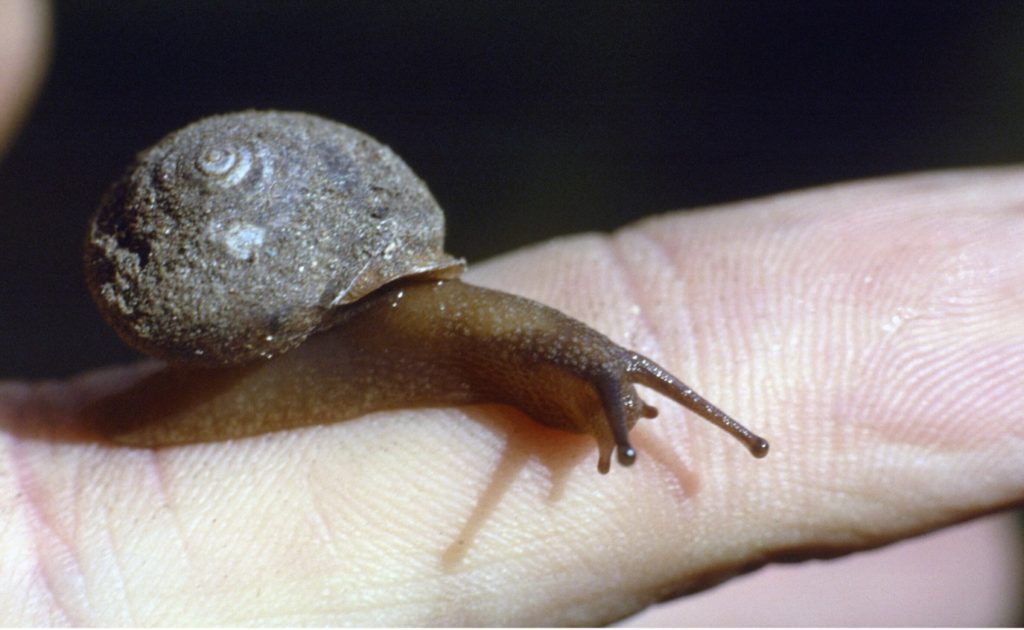by Dr. Timothy A. Pearce
A reader recently asked whether snails can feel love. I sometimes wonder that too; do my pet snails feel any affection for me? I don’t know the answer, but I’ll discuss this intriguing question from two perspectives: biochemical and philosophical.
Biochemically, many of our emotions are influenced by hormones. For example, higher levels of the hormone oxytocin are associated with greater trust and affection. Hormones in other species might have similar effects, for example, oxytocin in octopuses is associated with behaviors that are reasonably interpreted as affection. Humans and octopuses are very different evolutionarily – the common ancestor between our lineages occurred a very long time ago, at least 500 million years ago. The presence of oxytocin as an influencing hormone in both humans and octopuses could be interpreted as, (a) the ability to produce and respond to oxytocin might have been present in all or most animals living 500 million years ago and consequently is present in most modern animals that descended from those ancestors, or (b) the ability to produce and respond to oxytocin might have evolved independently in the lineage that led to humans and in the lineage that led to octopuses. A recent paper (Kumara et al. 2020) reported oxytocin-like proteins in a wide variety of vertebrates and invertebrates, suggesting the first possibility, that oxytocin might be widespread in animals due to shared common ancestry. If oxytocin, and other hormones that are associated with what we humans experience as love, are present in snails, then it could be reasonably argued that snails at least have the potential to feel love.

Philosophically, in an evolutionary perspective, what would love be good for? Love in the broad sense might be useful in social organisms to strengthen bonds between individuals such as partners, parents and offspring, and group members working toward a common goal. Inter-species bonds, such as humans and their pets, or even between individuals of non-human species, are reasonably interpreted as manifestations of love. However, these evolutionary benefits of love are for social species, and I can’t think of any social snails. Snails do not show evidence of mate fidelity or parental care, and they do not seem to crave each other’s company. Although snails sometimes gather in large numbers, my study of such aggregations suggests mutually valued resources are the cause of such occurrences rather than a desire to be together (Pearce & Porter 2011). So, I can’t think how the capacity to experience love would be useful to a snail in a way that evolution could select for a snail’s ability to feel love.
Snails do copulate, for reproduction, and that can be interpreted as a form of love. Some snails use calcareous darts, often called “love darts” as part of a courtship dance before copulation (the darts themselves are not used in sperm transfer). Reproductive behaviors are probably influenced by hormones. I like to think that snails find reproduction to be a pleasurable experience, but we really don’t have much idea what is pleasurable to a snail.
We sometimes use the word love to mean intense liking. In this sense, snails might have the capacity to love. I have noticed some of my pet snails are so attracted to cucumbers that I commonly say, “Snails love cucumbers.” I interpret the consumption of cucumbers as being deeply satisfying to snails.
In summary, snails might have the biochemical potential to feel love, but they might not have a socially-mediated evolutionary reason to feel love. They engage in reproductive behaviors, but we don’t know whether they feel love or pleasure during reproduction. At least some snails seem to have an intense like for cucumbers. Maybe snails do feel love, and maybe they don’t; we don’t know. You are free to believe as you like. Your pet snail Fluffy might really love you!
Timothy A. Pearce, PhD, is the head of the mollusks section at Carnegie Museum of Natural History. Museum employees are encouraged to blog about their unique experiences and knowledge gained from working at the museum.
Literature Cited
Kumara, S., Vijayasarathya, M., Venkatesha, M.A., Sunita, P. & Balaram, P. 2020. Cone snail analogs of the pituitary hormones oxytocin/vasopressin and their carrier protein neurophysin. Proteomic and transcriptomic identification of conopressins and conophysins. Biochimica et Biophysica Acta (BBA) – Proteins and Proteomics, 1868(5): 140391
Pearce, T.A. & Porter, K.A. 2011. Do Philomycus carolinianus (Gastropoda: Philomycidae) prefer to congregate? Nautilus 125: 83-85.
Related Content
Do Plants Have Lips? No, But One Genus Sure Looks Like It Does!
Leaping Slugs! Did That Slug Just Jump?
Carnegie Museum of Natural History Blog Citation Information
Blog author: Pearce, Timothy A.Publication date: February 14, 2022
